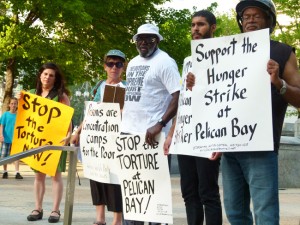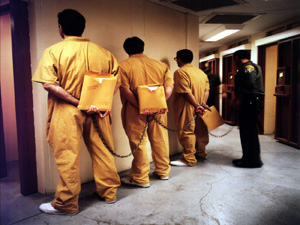By Deborah Dupre, Human Rights Examiner
July 9, 2013
In protest of California prison torture chambers, some 30,000 desperate inmates began a hunger strike Monday morning, according to reports by human rights defenders and state officials. Torture in America’s prisons is the nation’s most pressing human rights issue and among the least recognized by the public.
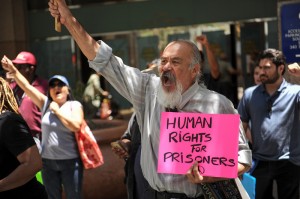
Guillermo Cuauhtemoc protests outside the Ronald Reagan State Building in downtown L.A. Monday, July 8, 2013, against solitary confinement in California prisons. (Michael Owen Baker/L.A. Daily News)
Approximately 30,000 inmates across two-thirds of the state’s 34 state prisons refused breakfast Monday morning and 2,300 refused to go to work or classes, reported the California Department of Corrections and Rehabilitation (CDCR) on Monday.
The torture chambers are officially called Security Housing Units, SHUs. Without sunlight or human contact, inmates have likened the SHU to a place where they are buried alive.
“The SHU conditions are torturous,” said Bilal Ali, a speaker and organizer with a coalition that demonstrated Monday in solidarity with inmates. “The [SHUs] are not right. I don’t want my tax money supporting it,” he said.
“The prisoners are saying that they screwed up and have to do their time, but they can’t be tortured,” Ali stated.
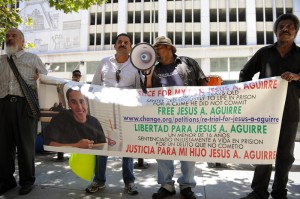
Protests outside the Ronald Reagan State Building in downtown L.A. Monday, July 8, 2013, against solitary confinement in California prisons. (Michael Owen Baker/L.A. Daily News)
CDCR spokeswoman Terry Thornton said that 4,527 inmates on Friday were housed in California’s SHUs.
Approximately 100,000 inmates across the United States are tortured daily by being in solitary confinement, more than any other country in the world.
(See: America’s 100,000 tortured inmates: Most pressing, ignored human rights issue)
With only five percent of the world’s population, the U.S. houses twenty-five percent of the world’s prisoners.
Profits keep America’s prison industry active.
The $50 billion a year state prison industry is led by California.
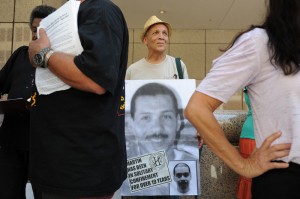
John A. Imani holds a sign outside the Ronald Reagan State Building in downtown L.A. Monday, July 8, 2013, during a protest against solitary confinement in California prisons. (Michael Owen Baker/L.A. Daily News)
That $50 billion excludes tens of billions spent by the federal government to police, prosecute, and imprison individuals.
What does this big business profit mean to taxpayers?
Californians pay $50,000 a year per prisoner under age 55; $150,000 per prisoner over age 55 for prison residency; and $184,000 a year per person on death row.
A seamless drug trade, planting drugs on innocent people and framing other innocent people in other ways all help keep prison cells full and demand high for more profitable prisons.
Californians rally in solidarity with prisoners protesting SHU torture
“Prisoners in Security Housing Units are forced to spend 23 hours a day in a small, window-less room with little contact with others,” Ali said. “Coalition members have been hosting events throughout California to push officials to make five system changes.”
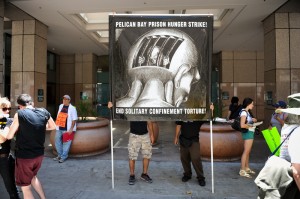
A pair holds a solitary confinement protest sign outside the Ronald Reagan State Building in downtown L.A. Monday, July 8, 2013, during a protest against solitary confinement in California prisons. (Michael Owen Baker/L.A. Daily News)
Prisoner demands since 2011 call for state officials to: reform policies that punish groups for individuals’ actions, stop rewarding those providing information on others, improve nutrition, institute constructive programs for those in solitary confinement and curtail long-term use of SHUs.
To help spotlight California’s tortured inmates’ plight, about 75 people rallied Monday in downtown LA outside the Ronald Reagan State Building. The rally was a kick-off of the hunger strike to protest solitary confinement that participants recognize as torture.
See photos: Protest in L.A. against solitary confinement in prisons
The Prison Hunger Strike Solidarity Coalition organized the rally. The coalition includes members from prison and human rights groups in LA. (Website at http://prisonerhungerstrikesolidarity.wordpress.com .)
CDCR officials say they will not recognize the hunger strike until more meals have been missed.
Are SHUs torture cambers?
CDCR officials also claim Security Housing Units are not “solitary confinement.”
The United Nations and the International Committee of the Red Cross recognize solitary confinement as torture.
Solitary confinement results in psychosis, insanity, and suicide, as confirmed by CIA researchers.
Solitary confinement effects include physical injury, human rights defender Andy Worthington has explained:
“EEG studies going back to the nineteen-sixties have shown diffuse slowing of brain waves in prisoners after a week or more of solitary confinement. In 1992, fifty-seven prisoners of war, released after an average of six months in detention camps in the former Yugoslavia, were examined using EEG-like tests. The recordings revealed brain abnormalities months afterward; the most severe were found in prisoners who had endured either head trauma sufficient to render them unconscious or, yes, solitary confinement. Without sustained social interaction, the human brain may become as impaired as one that has incurred a traumatic injury.”
“If the public at last begins to acknowledge long-term solitary confinement as a form of torture and a major human rights issue, it will be owing largely to the efforts of these activists – and to a group of prisoners who, for a few weeks this summer, starved themselves in solitude to bring their torment to light,” stated Solitary Watch’s James Ridgeway and Jean Casella – in July 2011 during California’s historical Pelican Bay Prison hunger strike.
(See: Historical 12,000 inmate hunger strike to end US prison torture, retaliation)
Even with some 16,000 California inmates participating in that 2011 hunger strike, corporate media failed to report the historical event, so the public continued failing to acknowledge the barbaric practice of torture through solitary confinement.
Today, twice as many California inmates are prepared to risk dying from starvation or retaliation (such as force-feeding) so the American public will recognize torture occurring as standard operating procedure on US soil, uphold human rights, reject the un-American, immoral practice of torture and pressure officials to do the same.
Russian novelist Fyodor Dostoevsky stated, “The degree of civilization in a society can be judged by entering its prisons.”


